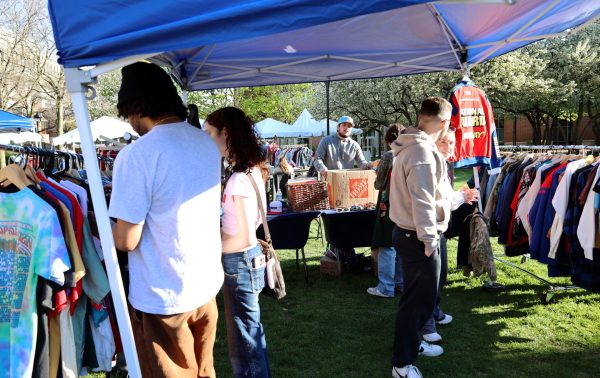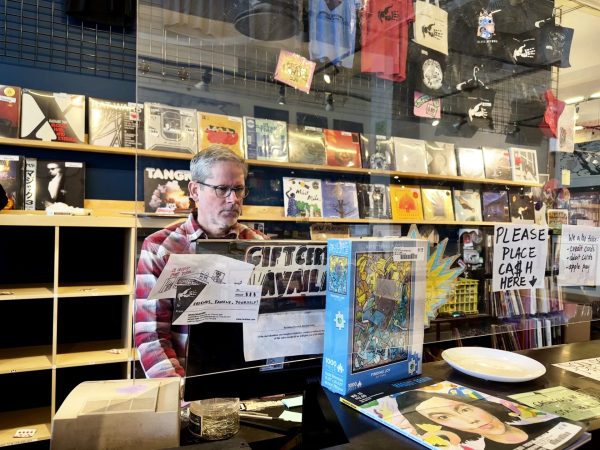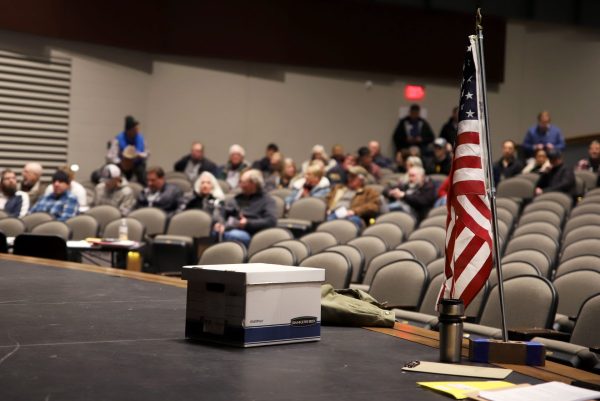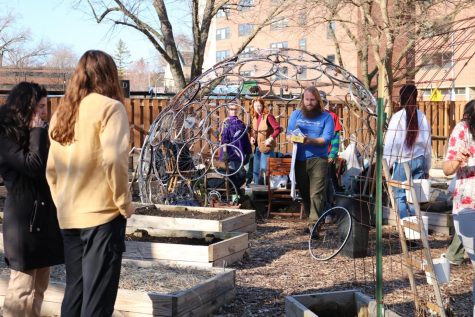OPINION: Englewood Whole Foods doesn’t adequately improve access to fresh food in neighborhood
Three years after a subsidized Whole Foods opened in Englewood, the upscale grocery chain has struggled to improve access to fresh food, due to higher costs and limited ready-to-eat foods.
Although Englewood and Streeterville are only nine miles apart, each community has a completely different experience in regard to how they access fresh and nutritional foods. A common denominator between the two disparate neighborhoods is now Whole Foods, though with notably different outcomes.
Each Whole Foods not only reflects the community with personalized murals and artwork, but also reflects what large corporations think of low-income neighborhoods, like Englewood, and how they plan to maintain business.
The Streeterville location is 48,890 square feet and includes a bar, pizzeria, five hot food bars, a pastry and treats cooler, sandwich shop, a butchery, fish market, bakery and more.
Englewood, on the other hand, is more than half the size at 20,000 square feet and has a butchery, fish market, pizzeria and bakery, maintaining notably less variety than its northern counterpart.
The Englewood location is open from 8 a.m. to 8 p.m., while the Streeterville location is open three hours more daily, from 7 a.m. to 10 p.m. While this can affect access to the store, Englewood’s residents are also less likely to work white-collar jobs with traditional business hours than Streeterville residents, studies show. This may only further limit residents’ ability to shop.
Daniel Block, a DePaul professor and an expert on food access, said in a lecture on “Deconstructing Food Access” that he has heard residents say their store is “not as nice and smaller” than other Whole Foods in northern Chicago, specifically the Streeterville location.
Both Whole Foods have Yelp reviews averaging in the three-star range. Englewood’s location has some positive reviews which praise the store for carrying local vendors’ products in their store. However, there are countless reviews that echo the frustration of the community’s shoppers.
One reviewer that goes by Yolanda T. said, “The hot food bar and it’s not even 12 noon. How am I supposed to enjoy lunch, with nothing prepared. This happens waaaaaayyyy too often.”
Yolanda T. recently took to Yelp to complain about the hot food bar not being stocked at noon.
Another Yelp reviewer named Wanda P. said, “Stopped by this new location today and was very disappointed I know this location has been opened for a short while I love to support my neighborhood stores but what are you people doing over there ? I stopped by to get a salad at the salad bar ,about 1pm I barely had items to make a salad the lettuce mix looked like it had been there for days had to request for fresh mix (they were not happy about that) but if im paying $7.99 ( way overpriced) salad bar needs to be fresh none of there selections for the salad bar were fresh everything looked days old the chicken was so under cooked that cannot be safe ,they lost a customer im definitely taking the drive to Mariano’s this location will not last what a shame smh.”
A former Whole Foods employee that worked at the Englewood location and the Irving Park location, who wished to remain anonymous because of his ties to the company, said Englewood community members are not treated as well in-store, compared with their northern counterparts.
“I went to Irving Park’s Whole Foods and bought a sandwich that was mislabelled,” he said. “The staff apologized to me, even as an employee, refunded me and let me keep the correct sandwich. If you went to Englewood, they would look at you and tell you, ‘What do you want me to do about it.”
He believes that the disproportionate responses are because the people that have decision-making power in the store, are not community members of Englewood, so they have no personal reason to invest in it.
The company’s choices to restrict some of what they sell leaves some to believe that the grocer is built to serve link customers.
Even though the hot food options are limited compared to the Streeterville location, the structures are still built into the store. The Englewood location has three hot food bars, though most were empty on the day of reporting.
The store has a built-in structure for rotisserie chicken with five shelves, but at 5:30 p.m. on a Thursday, there was only one chicken for sale.
Another notable difference is that the Englewood location does not have a large floral section in their produce department like other Whole Foods locations.
Derrick Givens, a recent DePaul alumnus, grew up in Englewood with his family. He believes that Whole Foods’ higher prices can keep community members from shopping at the luxury grocery store.
“Not everyone can afford it everyday,” Givens said. “Maybe the middle class, working class, you know it’s affordable to them. For someone who probably has link or doesn’t have a stable income, you know they will probably go somewhere else to get their food.”
The former Englewood Whole Foods employee said he is not surprised Englewood residents are not using Whole Foods as their primary grocer.
“When you are used to spending $3 on your lunches, you’re not exactly going to spend $9 on mac and cheese,” he said.
Having fresh food that the community can’t afford can still affect the community’s access to fresh and nutritional food. Block said he believes former Mayor Rahm Emanuel added the subsidized store in 2016, for reasons that extend past food access.
“I think a lot of the reasons why a lot of politicians like Rahm Emanual and Obama like the term food desserts, and doing this kind of thing, is because it’s measurable,” he said.“You can plop one store down and say 20,000 to 30,000 have more access. It doesn’t have to be good access.”
For Givens’ grandmother, having a Whole Foods five minutes away has improved her access to fresh produce. Before the Whole Foods opened, she may have had to commute for 25 minutes on public transit to a Fair Play for produce.
According to Givens, she “had to really wash it.” For her, the extra money is worth it to have access to fresher and cleaner produce.
An analysis by NYU School of Medicine found that Streeterville and Englewood have the largest life expectancy gap of any U.S. city. There is a 30-year gap, with Streeterville residents living to about 90, while Englewood residents only live to around 60 years old.
Aside from a gap in lifespans, there is also a large household income divide. The average household income in Streeterville is $159,284.90, while in Englewood, the average household income is $32,722.10.
Regardless of the pros and cons of what the Whole Foods has to offer, a consistent message from those interviewed resounds: Residents would have preferred a different grocery store.
“I would say something like a Fair Play, maybe a Pete’s or maybe a Jewel Osco,” Givens said.
The DePaulia reached out to Whole Foods for comment, but they did not respond by the time of publication.
















Gisella • Jul 1, 2020 at 7:53 am
I’ve been a resident of Englewood since 2005 having come from the Hyde Park and Oak Park area(s) and applaud all efforts and good intentions of those deciding to build a WF in the “hood”:)!
My family’s shopping style has never been limited to only 1 store or brand like Jewel, Food For Less, Pete’s, etc. I believe others share same experience seeing that no 1 store can possibly accommodate every consumer need and Personal choices – so having the option of various shopping experiences was important to me! For instance, I like to eat smaller chicken wings and NOT the steroid injected looking chicken wings I often see at the more “affordable” store chains ( smaller ones if available costs more)..Then there’s this thing called “ambiance” where neat, tidy, organized, herbal smells and aromas have a good affect, mind and soul on a person compared to driving through a parking lot full of trash only to enter a store smelling more like a meat slaughter house at worse, but often just not Being inviting or pleasant to the senses. I try to be an educated consumer and just won’t pay a certain amount for an item, even at WF knowing I can buy it substantially cheaper ( a few extra cents or a dollar isn’t worth me driving elsewhere though) if I can get it at WF. I’ll Even pay substantially more for a unusual or unique item if I’m in a mood where I want a different experience for a special occasion, and that might be personal to me (or not).
For sure, Englewood’s WF is not given the same consideration or attention as its northern counterparts, but it’s a start and I can shop local! Give me options and let ME decide what I want to spend premium $ for – I’ll cut back on other things that don’t go into my body, please. I don’t want another Food 4 “not much less” in Englewood. I don’t want a Jewel who may have had an opportunity to invest in Englewood and did not or could not. Keep Whole Foods but improve it.! ….. my opinion anyway!
Betty Jones • Feb 16, 2020 at 8:18 am
I was born and raised in Englewood during a time when shops were plentiful. . .Englewood was only second to downtown Chicago. Groceries were not in short supply. A store was available in the basement of Wieboldt’s and Sear’s (Hillman’s); A & P and another store I believe was called Del Farms, were all along 63rd Street between Peoria and Union. Yes, it has changed dramatically over the years. A little more than ten years ago I worked as Director of Sales on a plan for transformation which included new single family homes and retailers. Originally, leadership was looking to place a Food for Less or Ultra Foods on the land. Ultra has since closed its doors and the Food for Less plan went by the wayside in part because of the cost to build. Former Ald. Thompson of the 15th Ward worked dilligently (prior to her death), with former Mayor Rahm Emanuel to convince Whole Foods to build. I am of the belief that until we work to build residences, in this community of empty lots, it will be difficult to attract larger retailers. The tax base isn’t there. This is supported by your comment citing the median household income of “$32,722.10”. I’m afraid we still have a long way to go.